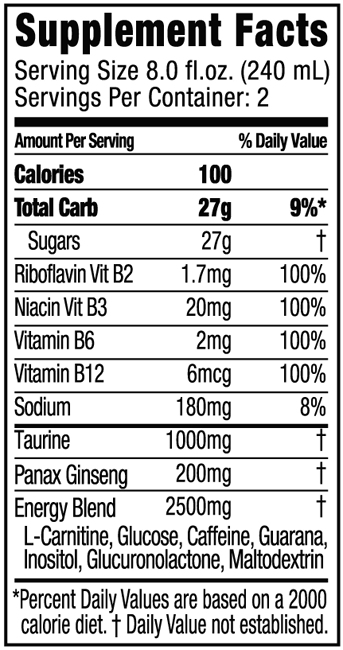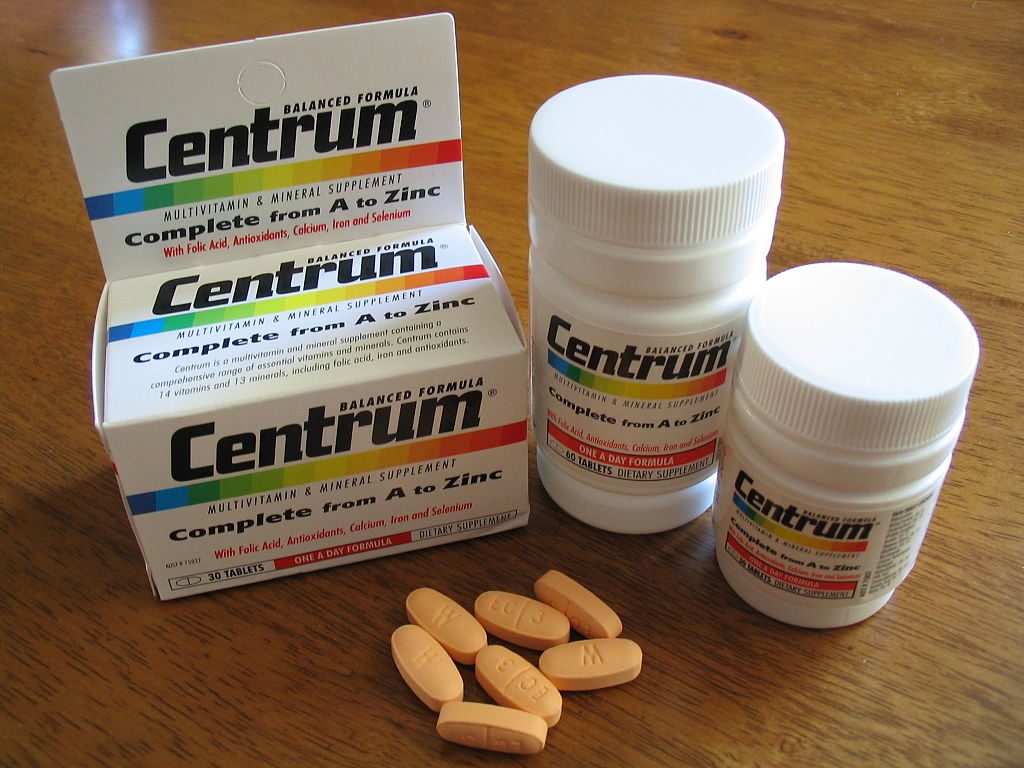Multivitamin/mineral supplements are dietary supplements that contain essential minerals and vitamins at doses needed to meet the nutritional needs of the average adult. Multivitamins have been consumed by Americans since the 1940s and remain the most widely consumed dietary supplements to this day.
Although eating a healthy, balanced diet is the best way to make sure you get all your vitamins and minerals, the reality is that many of us don’t manage to do so. This means that millions of people may have insufficient levels of certain nutrients. For example, while the recommended daily amount of vitamin A is 900 mcg for adult males, the average American man consumes only about 649 micrograms. As such, the main goal of multivitamin supplements is to provide a form of “nutritional insurance” – that is, to be absolutely sure that your intake of vitamins and minerals is at the recommended levels needed to support their essential biological functions in the body.
Even though nutritional deficiencies are rare in the developed world, suboptimal vitamin and mineral intake is actually quite common. Indeed, according to some recent estimates: 1
- 34% of Americans fail to get enough Vitamin A
- 5% fail to get enough Vitamin C
- 70% fail to get enough Vitamin D, and as many as 1 billion people worldwide 2
- 60% fail to get enough Vitamin E
- 38% fail to get enough Calcium
- 45% fail to get enough Magnesium
Intake above deficient but below recommended levels can not only negatively impact the essential biological roles of vitamins and minerals, but has also been linked to increased risk of chronic health conditions ranging from cardiovascular disorders to osteoporosis.
Recommended Dietary Allowance and Daily Value

The RDA should not be confused with Daily Value (DV) – a percentage value which expresses how much of a nutrient is present in a serving of the given food or supplement in relation to its daily need. For example, a 70% DV for vitamin A would mean that a serving contains 70% of the required daily amount of vitamin A. The DV can be found on labels of foods and dietary supplements.
In addition to the RDA and DV, another important measurement to keep in mind is the tolerable upper intake level (UL). The UL is the highest level of nutrient intake that is likely to pose no risk of adverse health effects to the average person. Intakes higher than the UL have an increasing likelihood of causing adverse reactions such as nausea, diarrhea, and constipation.
Do Multivitamins Help Prevent Chronic Health Disorders?
In addition to making sure that you get the recommended intake of vitamins and minerals, another popular reason for taking multivitamins is to decrease the risk of developing chronic health problems such as cardiovascular, neurological, digestive, and metabolic disorders.
However, research findings on this topic are mixed and inconclusive. Furthermore, one common issue is that most studies are observational, meaning that the researchers can only establish an association between multivitamin use and some health variable, rather than a direct relationship. As such, the current stance of the medical community is that there isn’t enough evidence to argue for or against the use of multivitamins in helping prevent chronic disorders. 3
Having said that, it seems that suboptimal levels of certain nutrients might increase the risk of developing a chronic health problem. For instance, there is some evidence that suboptimal levels of vitamins B6, B9, and B12 are risk factors for developing cardiovascular disorders, and that low vitamin D levels may increase risk of bone fractures and osteopenia. 4 In addition, subclinical nutrient deficiencies may also be involved in general fatigue, weakened immune system function, and other common health issues. 5 6
Clarification: Deficiency vs. Subclinical Deficiency
It’s important to highlight the difference between true nutrient deficiency and subliclinical deficiency/insufficiency, because although most people in developed countries are not deficient in any vitamin or mineral, their nutrient status can still be suboptimal.
Nutrient deficiency refers to a state where you get so little of a nutrient that it can lead to a wide range of serious health problems; such deficiencies are a common problem in the developing world. By contrast, subclinical deficiency, also known as insufficiency, is when your intake of a nutrient is higher than deficient, but still below recommended levels. Subclinical deficiency does not necessarily present any symptoms, but can make you more susceptible to health problems and chronic disorders.
Are Multivitamins Safe?
Generally speaking, multivitamins are safe to consume and do not cause any side effects. However, there is a possibility of having too much (more than the UL) of a nutrient when taking multivitamins alongside other supplements or fortified foods, which increases the risk of adverse side effects. For example, excess vitamin D intake may cause nausea and vomiting.
13 Essential Vitamins
Vitamins are present in food and are required for the proper functioning of processes essential to life, such as energy production and synthesis of biological molecules such as DNA, fatty acids, neurotransmitters, and hormones. Although vitamins are considered essential nutrients because they cannot be produced by the body, some – most notably vitamins D and K – can actually be synthesized by the body in moderate quantities. There are a total of essential 13 vitamins:
Vitamin A
Vitamin A is best recognized for its role in immune system function and vision, but as many as 34% of Americans have insufficient levels. This vitamin can be found in adequate quantities in both animal products (in a form readily usable by the body), and fruits/vegetables (in a form that first needs to be processed by the body, such as beta-carotene). More on Vitamin A in multivitamins.
Vitamin B1
Also known as thiamine, vitamin B1’s major function is to help the body generate energy from carbohydrates and proteins. As the case with other B vitamins, animal products such as meat are some of the best sources of vitamin B1, in addition to fortified cereals. More on vitamin B1 in multivitamins.
Vitamin B2
The main role of B2 – also called riboflavin – is to help extract energy from food. In addition, it also helps the body produce vitamin B3 and turn B6 into PLP, its active form. Animal products such as eggs, milk, kidney, liver, and lean meats are all good sources of riboflavin. More on vitamin B2 in multivitamins.
Vitamin B3
Vitamin B3, also called niacin, plays a role in energy metabolism by helping break down and synthesize carbohydrates, fats, and proteins. B3 supplementation has also been shown to aid in regulating the levels of cholesterol and other blood lipids. Meat and seafood are the best sources of this vitamin, but smaller quantities are also present in grains and dairy products. More on vitamin B3 in multivitamins.
Vitamin B5
Better known as pantothenic acid, vitamin B5 is most recognized for its role in helping extract energy from food and produce essential molecules such as hormones, fats, and proteins. Good dietary sources of B5 include animal products, whole grains, and some vegetables. More on vitamin B5 in multivitamins.
Vitamin B6
Vitamin B6 is known for being involved in over 100 chemical reactions that aid energy production, blood cell function, and other essential processes. Meat and fish are great sources of B6, as well as some vegetables such as sweet potato and spinach. More on vitamin B6 in multivitamins.
Vitamin B7
Also known as biotin, vitamin B7 is most important for its role in energy metabolism – the production of energy from carbohydrates, fats, and proteins. B7 is present in a wild variety of foods, with particularly high levels in bananas and peas. More on vitamin B7 in multivitamins.
Vitamin B9
Vitamin B9, also known as folate and folic acid, is best recognized for its role in the production of DNA and amino acids. Leafy greens such as spinach, broccoli, and turnip greens, and dried legumes such as chickpeas and beans are excellent sources of B9. More on vitamin B9 in multivitamins.
Vitamin B12
Popularly known as the “energy vitamin”, B12 is most important for its roles in energy production, brain health, and the formation of DNA and blood cells. B12 is only found in animal foods, which explains why vegans may have insufficient levels. Older adults can also benefit from supplementation because as many as 30% may have trouble absorbing B12. More on vitamin B12 in multivitamins.
Vitamin C
Vitamin C is arguably the best known vitamin, and also one of the most popular dietary supplements in the world. This vitamin plays an important role in bone, tooth, and skin health by helping produce collagen, a key component of connective tissue, in addition to boosting the body’s antioxidant defenses and helping the immune system function properly. Fruits are the best sources of vitamin C, with guavas, papayas, and oranges having particularly high levels. More on vitamin C in multivitamins.
Vitamin D
Popularly known as the sunshine vitamin because sun exposure promotes its synthesis in the skin, vitamin D has important roles in both health and immune system function. Low vitamin D levels are actually quite common in the developed world, with as many as 42% of Americans being deficient and 70% having insufficient intake. Good dietary sources of vitamin D include fatty fish and fish liver oil, as well as fortified milk and cereal. More on vitamin D in multivitamins.
Vitamin E
Much like vitamin C, vitamin E is largely recognized for contributing to the body’s antioxidant defenses that help protect cells from damage caused by oxidative stress. Nuts and sunflower seeds are among the best sources of this essential nutrient. More in vitamin E in multivitamins.
Vitamin K
Vitamin K is best known for its role in blood clotting, but is also necessary for bone health and preventing the calcification of blood vessels. The best dietary sources of vitamin K are dark leafy vegetables such as kale and spinach. More in vitamin K in multivitamins.
Vitamin B8 (Non-essential)
Vitamin B8 is another name for inositol, a compound that is no longer considered a vitamin because it is not essential – it can be produced by the body in adequate quantities unlike the vast majority of vitamins. Inositol’s most important role is cell signaling – the communication between cells and outside molecules that affect their function. High-inositol foods include brown rice and citrus fruits. More on vitamin B8 in multivitamins.
Minerals
Minerals are chemical elements that – much like vitamins – are required for the proper functioning of a wide range of life-sustaining processes. Minerals can be divided into two groups:
- Macrominerals – calcium, phosphorus, magnesium, sodium, potassium, chloride and sulfur – which are needed in relatively large doses
- Trace minerals – iron, manganese, copper, iodine, zinc, cobalt, fluoride and selenium- which the body needs in small quantities
Types of Multivitamins
Most multivitamins can be considered “broad spectrum” in the sense that their goal is to provide most or all essential nutrients needed by the average adult at close to recommended daily doses. However, there is also an increasing number of specialized multivitamin products that are designed for a particular group of people or a specific purpose. Health professionals recommend that people choose a multivitamin that is best suited for their sex, age, and lifestyle.

Prenatal Multivitamin
Pregnancy can increase the need for certain nutrients, such as calcium and vitamin D to support bone health and iron to enable increased blood cell production. In addition, clinical research suggests that folic acid helps reduce the risk of neural tube defects in the baby. Prenatal multivitamins are designed to meet such specific needs, helping support both the mother’s and the baby’s health.
Multivitamins for Men
Men’s multivitamins are specifically formulated to meet the nutritional needs of men and to support male health concerns, such as energy, muscle function, and sexual health. Such formulations can also be further specialized for active men, in which case they often include amino acids to support muscle health and energy, and may even have herbal and other ingredients.
Multivitamins for Women
Much like men’s multivitamins are calibrated to meet the specific nutritional and health needs of men, so are women’s multivitamins designed specifically for women. For instance, one common concern for postmenopausal women in particular is bone loss. Just some of the health areas women’s multivitamins focus on are:
- Hormonal balance
- Bone health
- Skin health
Multivitamins for Older Adults (50+)
As we get older, some nutrients become harder to absorb and utilize. Just as we start needing more nutrition, it seems that the body has a harder time using it. This issue is further troubled by the fact that nutrition among American adults aged 50-64 is in need of “major improvement” according to a recent report by the CDC. 9
One approach to this problem are multivitamins designed specifically for older adults. For example, these multivitamins typically contain higher levels of vitamin B12 because it is more difficult to absorb for people over 50. In addition, many multivitamins designed for older adults also address the issue of aging and age-related health problems, such as vision loss and memory deterioration. This is done not only by calibrating the dosages of essential nutrients and antioxidants, but also by adding other non-essential ingredients such as herbs and probiotics.
Multivitamins for mature adults can further be specialized by gender, and come in versions for other age groups, such as 65+ multivitamins.
Whole Food Multivitamins
Whereas typical multivitamins use synthetically made versions of vitamins and minerals, whole food multivitamins attempt to maintain these same nutrients in their natural form, extracted directly from fruits, vegetables, and other foods and herbs. In addition, whole food multivitamins typically contain other natural ingredients such as enzymes, antioxidants, and other phytonutrients – plant chemicals with health-promoting properties.
The claim made by manufacturers of such products is that the body can absorb and use them more effectively since the nutrients are present in a form closer to how they are normally consumed as food. However, there currently isn’t any research evidence to back such claims.
Conclusion

Surveys suggest that a large portion of Americans are not getting enough of some essential vitamins and nutrients in their diet, which may increase the risk of chronic disorders such as osteoporosis and general health issues such as fatigue. As such, taking a daily multivitamin can be a cheap and easy way to be absolutely certain that your intake of essential nutrients meets recommended levels.
Having said that, however, it’s always best to get all your nutrients from a healthy, balanced diet. After all – by their very definition – dietary supplements such as multivitamins are meant to supplement your diet, not be its replacement.
